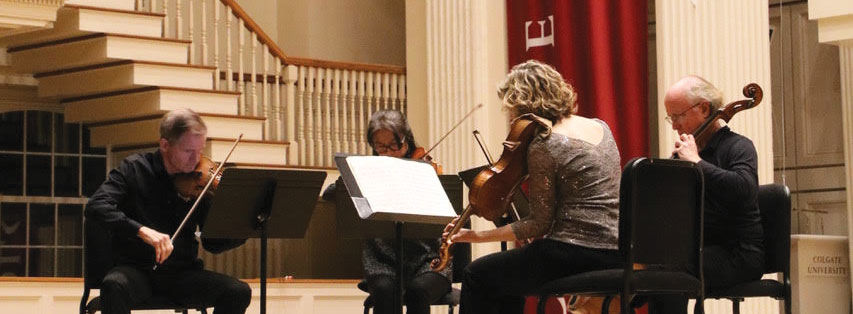Manhattan String Quartet Visits Colgate
The Manhattan String Quartet, which has been in-residence at Colgate since 1988, played a concert on Friday, November 8 sponsored by the CORE and Music departments. The quartet has a long and storied career—with highlights such as a full tour of the Soviet Union in 1985, success in sold-out shows in 1986 and 1989 and a tour of Asia in 2005. This year, however, brought changes to the group’s lineup for the first time in years. Joining long-time members Curtis Macomber (violin) and Chris Finckel (cello) were Anna Lim (violin) and Dainelle Farina (viola).
As audience members settled into the pews, notes carried through the Chapel as musicians tuned their instruments. The tuning of any musical group always creates some fantastic tension, as it anticipates the night that has yet to unfold.
The tension broke as the group walked on stage. Some audience members might have recognized them from the previous night when they helped Professor of Music Ryan Chase demonstrate the evolution of Western classical music during his lecture in the chapel. Finckel reintroduced the group, and explained that the performance would be different than the night before.
“We’ve talked so much, you’ll have to pardon me if we don’t say a whole lot this evening” Finckel said.
They began the concert with Haydn’s 1772 Quartet in F Minor, Opus 20 No. 5. It was a wonderful piece from the father of string quartets, performed with clarity and warmth. It snuck between shades of light and dark, adventurous and smooth. It ended with a fugue—wherein a melody is played at first in one voice, then passed around and heard throughout the piece as derivative material is played alongside it, all while sounding coherent. This particular fugue was in two voices, and made for a resounding ending.
Next was Janacek’s String Quartet no. 1 (1923), the “Kreutzer Sonata.” Full of gorgeous textures and lush harmonies, it was not short of invention or theatrical effects, employing a vast array of extended techniques and non-traditional harmonies. It is a true example of art triumphing individualism in the established canon, and how art makes us question our own tastes in response to itself. The languages being used in this piece are inherently and uniquely its own—more so than the intricate languages of music from prior eras in the Western tradition. It threatens to break into something alive, close to a riveting and pulsing that pushes audience members to the edge of their seats, yet falls flat. While there are great moments, a great piece is more than that.
Finally, the night was topped off with a spectacular performance of Beethoven’s String Quartet no. 9, Op 59 No. 3, the third and last of the “Razumovsky” series of commissioned quartets. Beethoven’s name remains momentous in music for a reason, and that is his emotion. The first two movements were excellent.The second movement featured cello pizzicato (plucking). The third movement, a minuet, was beautiful and graceful, adventurous and playful. It dovetailed spectacularly into the final movement—a fantastic fugue, a feat of musicianship for both composer and player on another level from Haydn’s fugue. This is due to the challenging subject danced around with four voices rather than two. The whole thing ended in an enormous crescendo, and leaving the audience feeling lighter, refreshed almost. Hopefully, this new arrangement of performers in the MSQ perform many more shows at Colgate; the students deserve this calibre of quality.










